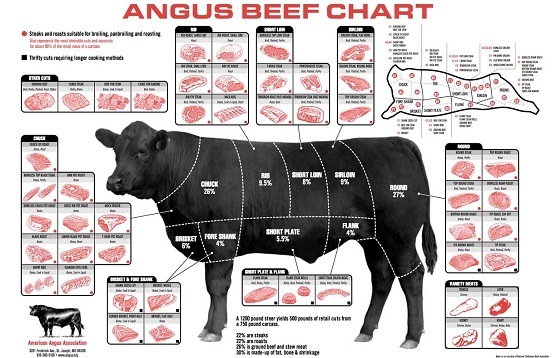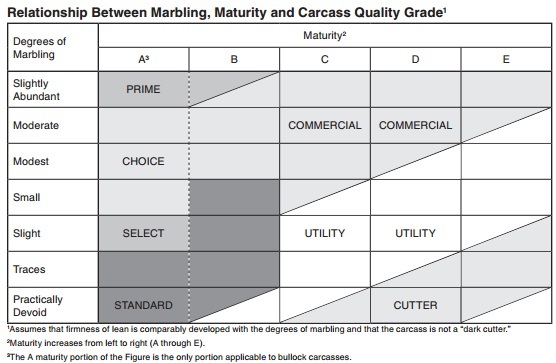Knowledge Base
Knowledge Base
Knowledge Base
Backgrounders/Stockers are terms sometimes used synonymously. Backgrounders are cattle operations that take weaned calves and feed them summer grass to add weight before being sent to a feedyard for finishing. This can also refer to the calves coming from these operators, particularly stockers.
Bull is a male bovine used as a sire in cattle breeding
Calf is the offspring of a bovine animal (domestic cattle) in its first year
Commercial cattle are cattle that are not purebred and are bred for harvest. Often times, commercial cattle or registered composite cattle are bred to have the qualities of two or more breeds.
Cow is a female bovine that has borne a calf
Cuts of beef refer to the portions of a bovine animal. In the U.S. and Canada there are 8 primal cuts. Each primal cut is further segmented.
- Chuck
- Rib
- Loin
- Round
- Flank
- Short Plate
- Brisket
- Shank
Feed Conversion/Feed Efficiency refers to the pounds of feed needed to add a pound of gain on an animal. This is perhaps the most important metric in the economics of animal protein production.
Feeder calves are less than 1 year old; feeder yearlings are between 1 and 2 years old.
Feeder cattle are steers or heifers mature enough to be placed in a feedlot where they will be fattened prior to slaughter. Feeder cattle are weaned calves just sent to the feedlots (about 6-10 months old), and live cattle are cattle which have attained a desirable weight (1150-1375 pounds for heifers, and 1200-1500 pounds for steers), to be sold to a packer. The packer harvests the cattle and sells the meat in carcass boxed form.
Heifer is a young female bovine that has not borne a calf
Live Cattle refers to cattle industrially-raised for beef production from the calf stage until they reach between 600 to 800 pounds. At this point, they are considered Feeder Cattle and are taken to feedlots to continue the fattening process. “Live” in marketing refers to selling cattle by weight, not carcass quality.
Marbling is the intramuscular fat in beef which gives it its tenderness and flavor
On the Grid refers to selling cattle at a price that is determined after harvesting, based upon the quality of the carcass on several metrics.
Preconditioning refers to the process of having calves receive vaccinations and being introduced to processed feeds after weaning
Premium is the price increase per pound paid by a packer for cattle carcasses that achieve certain hurdles
Price Differential refers to the difference is price per pound of calves based upon gender or quality.
Quality Grade refers to the USDA grading system using marbling and maturity as its axes1. There are separate formulas for marbling and maturity which ultimately go into the Quality Grade. Quality grades in decreasing order are:
- USDA Prime
- USDA Choice
- USDA Select
- USDA Standard
- USDA Commercial
- USDA Utility
- USDA Cutter
- USDA Canner
Steer is a castrated male bovine
Yardage is the cost of housing one head of cattle, commonly quoted per day or month. Think of it as your hotel room cost.
Yield grades are expressed in numbers that estimate the percentage of expected cutability from a carcass. Cutability is defined as the percentage of closely trimmed, boneless, retail cuts from the round, loin, rib and chuck — the four major beef wholesale cuts. It is an estimate of the relative amount of lean, edible meat from a carcass. The yield grade is determined by evaluating four carcass factors:
- External fat thickness over the ribeye
- Ribeye area
- Estimate of the percentage of kidney, pelvic and heart fat
- Hot carcass weight
There are five yield grades: USDA yield grades 1, 2, 3, 4 and 5. The lower the numerical value of the USDA yield grade, the higher the expected yield of closely trimmed, boneless retail cuts. A yield grade 1 carcass provides the greatest amount of saleable beef while a yield grade 5 is the lowest-yielding carcass. Producers tend to use yield grades more than consumers. The yield grade is important to producers because it can affect animal value and the overall economic returns from the animal. Consumers are more familiar with quality grades, which are used to predict meat palatability.
Yield Grade Formula = 2.5+(2.50*Adj. Fat Thickness, inches)+(0.20*%Kidney, Pelvic and Heart)+(0.0038*Hot Carcass Wt., pounds)-(0.32*Ribeye Area, square inches)
The Yield Grade for a carcass that weighs 760 pounds, has an Adj. Fat Thickness of 0.50 inches fat, 2.5% KPH and 13.2 sq. inches of REA = YG = 2.5 + (2.50*.45) + (0.20*2.5) + (0.0038*700) – (0.32*13.2) = 2.914.
This carcass would be marketed as a YG2 because the decimals are dropped and not rounded.
Herd Types
Cow-calf operations maintain a breeding herd of cows, replacement heifers (young females) and bulls. Steer calves and most heifer calves are sold, but some may be selected to enter the breeding herd. Calves are sold at weaning (typically 205 days of age) or are retained for an additional forage production season as stockers. Climatic and management conditions dictate different calving seasons in different regions.
These cattle are typically purebred British or Continental breeds or a cross of several beef breeds, known as a composite. Though the list of breeds is quite long, some of the more recognized beef cattle breeds are Angus, Hereford, Charolais, Brangus, Maine-Anjou, Simmental and Limousin.
Seedstock production is a specialized cow-calf operation that produces purebred or registered cattle. The goal of seedstock production is to make genetic improvements in cattle that benefit the entire beef industry. Improvements in purebred cattle are documented through extensive records maintained by both the individual rancher and breed organizations. Seedstock are marketed as bulls and replacement females to other seedstock producers or to cow-calf producers.
Stocker operations grow steer and/or heifer calves or yearlings on rangeland or other roughage. Generally, cattle are purchased following weaning in the fall and are wintered on low quality feed until new grass can support the animals’ nutritional requirements. Generally, cattle are purchased following weaning in the fall and are wintered on low quality feed until new grass can support the animals’ nutritional requirements. Stocker cattle are normally marketed or transported to feedlots at the end of the grazing season when nutritional quality of the forage begins to decline.
Feedlots/feedyards are facilities designed to meet the feed, water and care requirements of large numbers of cattle. Beef fed solely roughage feeds take longer to reach market weight and condition, and land resources in the U.S. are insufficient for a forage-based beef supply at the current level of consumer demand.
Feedlots utilize abundant sources of feed grains and by-products to efficiently feed large numbers of cattle. These higher energy feed sources greatly reduce the time required to reach market weights. By feeding cattle in feedlots, finished cattle weighing 1,200 to 1,500 pounds can be marketed at 16 to 22 months of age.
There are many phrases used in today’s beef industry. Marketing terms like grass-fed, corn-fed, natural and organic are just a few of these terms. While all beef provides high quality nutrition, consumers in today’s world have a variety of options in selecting beef for their dinner table depending on their budget and preferences.
1. USDA Beef Quality and Yield Grades USDA Beef Quality and Yield Grades
Basics of Investing in Feeder Cattle
If you are new to investing in feeder cattle, start here

